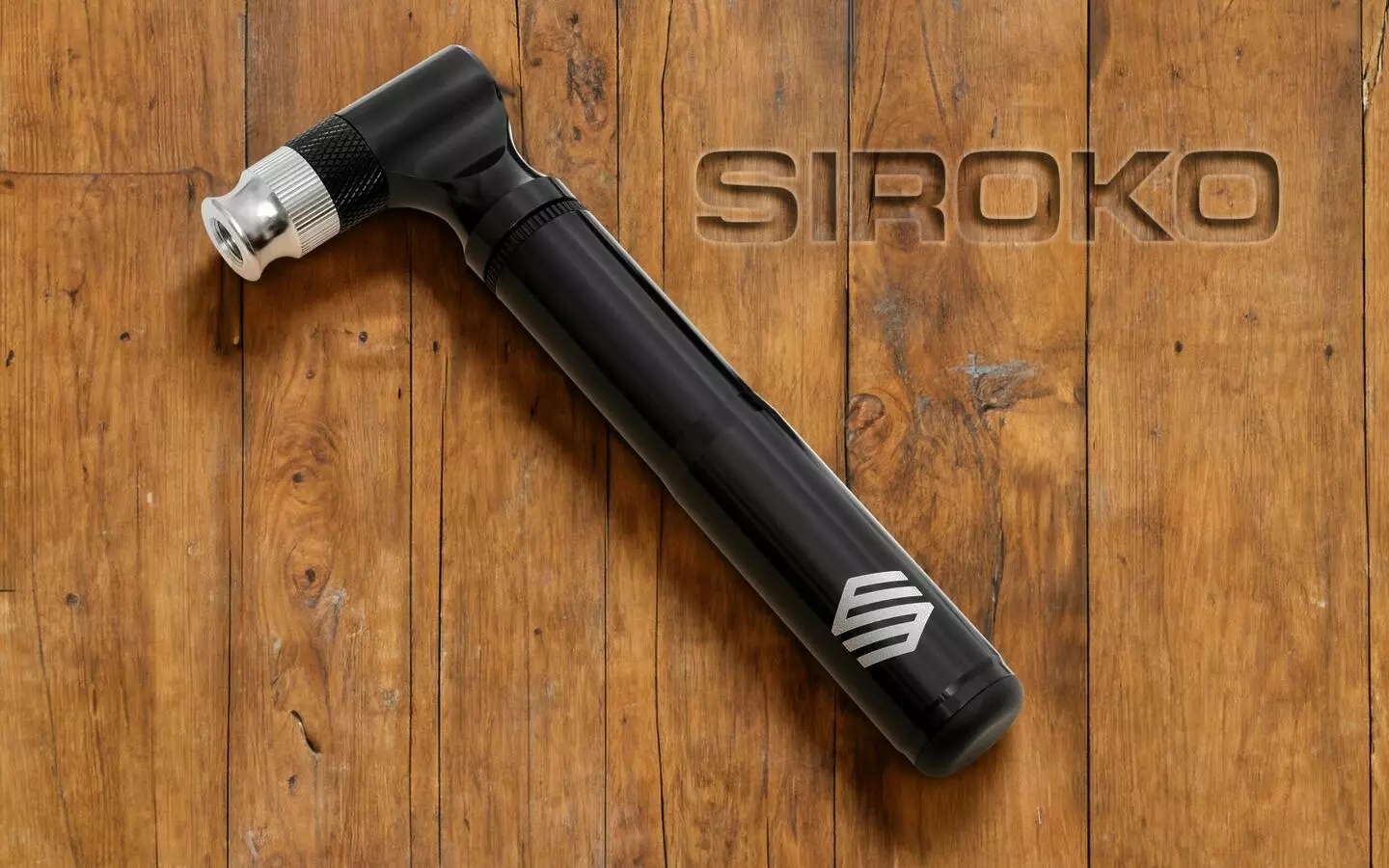As a cyclist, sooner or later, you’ll face the challenge of a flat tire and the need to repair and inflate it. The two most common methods for inflating a tire are traditional hand pumps and modern tire inflators that use CO2 cartridges. While electric mini-pumps are becoming more popular, they remain an alternative option for now. In this blog post, we’ll explore the pros and cons of these two primary methods to help you decide which one suits your needs best.
Traditional pumps
By “traditional” hand pumps we mean those you probably see first in stores, which are also the ones the vast majority of cyclists use. These pumps come in different sizes, but mid/small-sized ones are probably the most common, since they can be easily attached to the bike frame or stored in the pockets of your jersey/jacket. Mini-pumps can also be stored in a saddle bag or a tool storage bottle.
Pros:
- Functional: Hand pumps don’t need CO2 cartridges to function, as they depend entirely on the effort you put in with your arms. Make sure to keep those muscles working to be able to face any punctures you may have, and properly inflate the tire with the right amount of pressure.
- Durable: If you take care of it, a hand pump can have a years-long lifespan, which makes for a great investment.
- Beginner-friendly: Inflating a tire with a hand pump can take a while, and you might struggle to reach the right amount of pressure, but the process is simple and perfectly works when on the go, allowing you to repair the puncture fast.
Cons:
- Time and effort: This process of manually inflating a tire can be tiring, especially if you’re using a mini-pump. It can take a while to reach the right amount of pressure and, depending on the type of pump, some will only do so much. Still, you can always carry a small adapter with you and use any pump you can find at the nearest gas station.
- Size: Mini-pumps can be easily stored, but they demand even more physical effort to inflate a tire. Mid/small-sized pumps are a much better option, but if you don’t want to force their way into the pockets of your cycling jersey, you’d need a mount to attach them to the bike frame.
- A more time-consuming option: As mentioned earlier, the smaller the pump, the more effort required. If you’re in a hurry, racing, or need a quick inflation, this pump might not be the best choice.
CO2 tire inflators
This method consists of attaching a compressed CO2 gas cartridge into a small inflator that restores the pressure in your tire in seconds. It is quite popular among cyclists who compete or participate in tours regularly, especially in MTB cycling, or those looking for the quickest, most portable option.
Pros:
- Quick: Inflating a tire can just take seconds with this system, which is great when you’re in a rush or in the middle of a long route.
- Compact and lightweight: They are easily stored thanks to the size of both the inflator and the CO2 cartridges, which can fit perfectly in the pocket of your jersey or in a tool bottle.
- Minimal effort: There’s no physical effort involved in this method, since you don’t have to pump and just need to attach the inflator to the valve.
- Seating tubeless tires: The force of CO2 inflators creates a powerful burst of gas, making it possible to mount a tubeless tire—something a regular pump simply can’t achieve.
Cons:
- Limited usage: You can’t reuse a cartridge once it’s empty, so if you use one incorrectly or experience several punctures on the way and run out of cartridges, you could definitely need someone to come pick you up. Choosing this method implies making sure you always bring more cartridges than spare tubes just in case. So, if you usually carry two spare tubes, bring three cartridges.
- Price: The inflator might be reusable, but the CO2 cartridges aren’t, which means that this method will always cost you money.
- Not the best option for beginners: If you don’t know how to use the inflator, you could be wasting air or injecting too much pressure in the tire, thus resulting in a bigger issue. If you’re a beginner and choose this method, make sure to practice first to avoid finding yourself in a difficult situation.
- Environmental impact: CO2 cartridges are single use, which undoubtedly generates more waste and CO2 emissions. To illustrate this better, a mid-sized car releases about 143 grams of CO2 per km, and a tire inflator cartridge has about 16 to 25 grams of CO2.
General recommendations on how to use a CO2 tire inflator
Using a CO2 tire inflator can be quite fast and convenient, but it is paramount to know how to use it properly to avoid wasting gas, damaging the tire or tube and, most importantly, hurting yourself. Here are some general recommendations on how to use a CO2 tire inflator efficiently.
1. Practice before a ride
It is advisable to get some practice using the inflator at home before going out for a ride. This way, you’ll be prepared in case of an emergency and won’t make mistakes that would result in needing someone to come pick you up.
2. Always act with caution around the inflator and cartridges
CO2 cartridges can get extremely cold to the touch once the air is released, which is why the vast majority of CO2 inflators include some type of cover for protection. If yours doesn’t come with any kind of protective cover, make sure to use gloves or some cloth to protect your hands and prevent burns.
3. Choose the right tire inflator
There are two types of CO2 tire inflators:
With a built-in air regulator: This type of inflator allows you to monitor the amount of gas that goes in the tire to prevent overinflating them. The regulator can also be used to adjust the tire pressure without having to use one whole cartridge if you don’t need to, but keep in mind that storing the inflator while a cartridge is still attached to it is advised against. The most common types of regulators come with a valve head that needs to be locked or threaded to control the air flow, but others work with a lever or even come with a gauge for extra psi control.
Without a built-in air regulator: Though cheaper and easier to use, this type of inflator empties the cartridge in one go, which means you don’t have control over adjusting the tire pressure to your needs. The only way to regulate the air flow is to put pressure over the valve in the tire while inflating it.
Beginners are advised to go for a tire inflator with a regulator to prevent small mistakes that come from lack of control or experience.
4. Use the right CO2 cartridges
CO2 cartridges come in different sizes: 16 g, 20 g and 25 g. Make sure you choose a size compatible with the type of tires you have:
16 g: Compatible with most road bikes.
20 g or 25 g: Recommendable for MTB bikes or wider tires.
Using a smaller cartridge on wider tires might not be enough to fully inflate it and have enough pressure.
Always make sure to check the end of the cartridge fits the inflator head.
5. Check valve compatibility
CO2 tire inflators are mostly compatible with the two most common types of tire valves: Presta (thin valve) and Schrader (thick valve).
Make sure the inflator is compatible with your tire valve or, alternatively, that it comes with an adapter for both types.
6. Using a CO2 inflator
Whether you have tubeless or clincher tires, the first thing you should do is repair the puncture, making sure there’s nothing around the wheel or still attached to it that can result in another flat tire.
Take a look at the following video if you use clincher tires:
If you use tubeless tires, it’s not as easy to get a puncture but that doesn’t mean it can’t happen at all. Here’s how to fix it:
Once the puncture has been repaired: if you use tubeless, make sure it’s properly set up to prevent leaks; if you use clincher tires, check the tube is not stuck between the tire and the rim.
Screw the cartridge into the inflator. Twist all the way in for inflators with a built-in regulator. Without a regulator, avoid twisting the cartridge all the way in to prevent puncturing the cartridge and releasing the air too soon.
Attach the inflator to the tire valve. Make sure the inflator head is tightly and properly adjusted around the valve of the tire. If you’re using a Presta valve, remember to unscrew the lock nut at the tip before inflating.
Release the air gradually. Use the regulator, if it has one, to slowly open the air flow and prevent inflating your tire too fast or too much, allowing you to stop once you have reached the right amount of pressure. Without a regulator, make sure you are ready to release the air, and pay attention to how much pressure goes in to prevent overinflation.
Stop the air flow once the tire is inflated. Use the regulator to cut the air flow when the pressure is the right one, and remove the inflator head from the tire valve.
Without a regulator, remove the inflator from the valve straight away and wait for the cartridge to release all the air.
Put the inflator away and keep the used cartridges. Empty CO2 cartridges must be recycled in the right compartment to reduce environmental impact.
Last but not least, it is advisable to deflate and inflate your tires with a floor pump once you get home, as using CO2 can result in the tires losing considerable pressure with time, which will make you think you have a new puncture or that the tire hasn’t been repaired properly. Also, keep in mind that CO2 doesn’t get along with the liquid sealant in tubeless tires.
Which one could work best for you?
It depends on your level, the cycling discipline, your own preferences and needs, and how in a rush you could be.
If you practice cycling for fun or don’t really have much experience, a traditional pump is the perfect choice, letting you inflate your tires at your own pace without worrying too much about the puncture disrupting your ride. Plus, using a pump is quite simple as you just need patience and strength.
If you like competing in tours, practice MTB cycling or would just rather pack light, a CO2 inflator is the one for you, but always make sure to practice before using it so that you can face a puncture with confidence.
In conclusion, you can find pros, cons and alternatives (such as mini hybrid pumps that could work just as well) for both methods, but the most important thing in the end is to always be well prepared on every ride.



